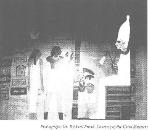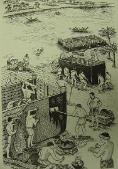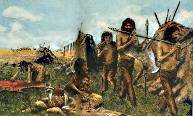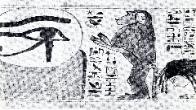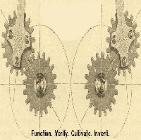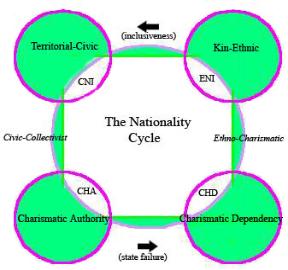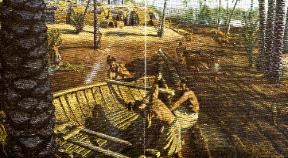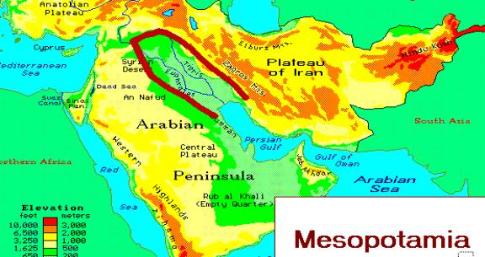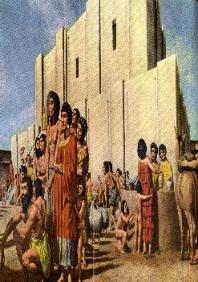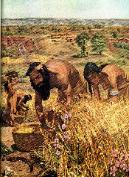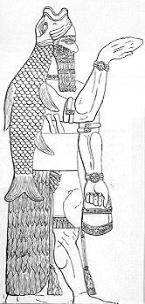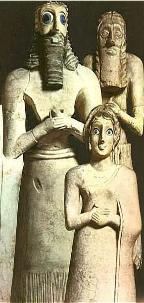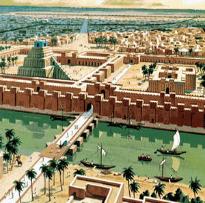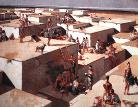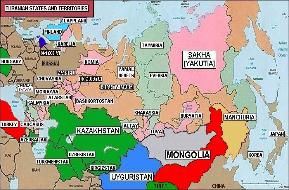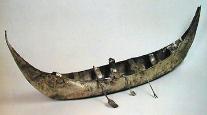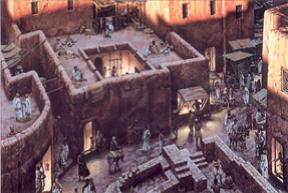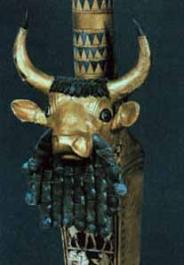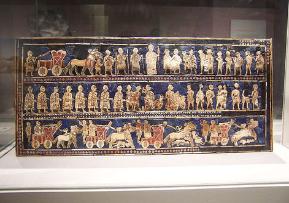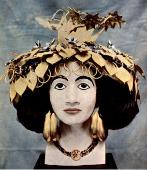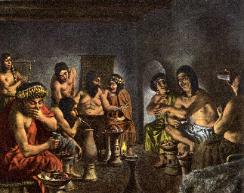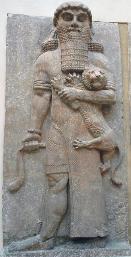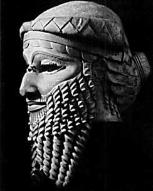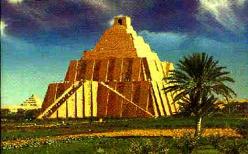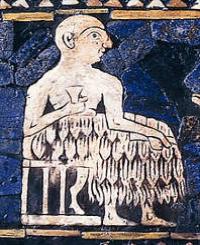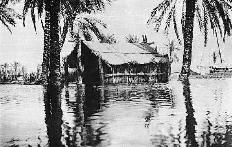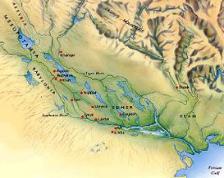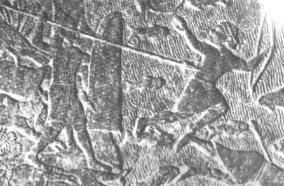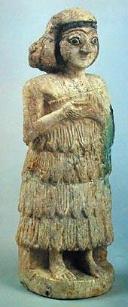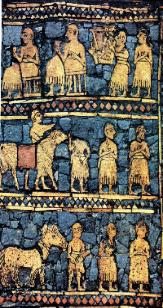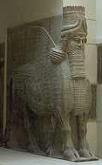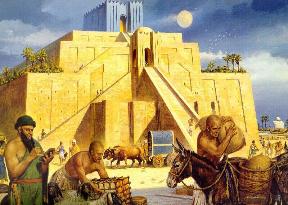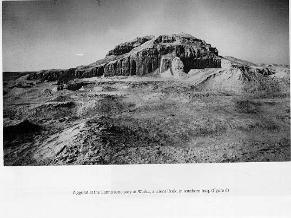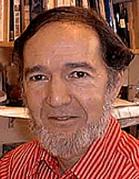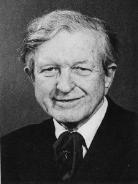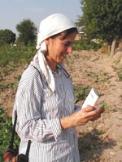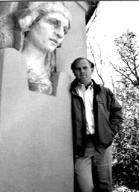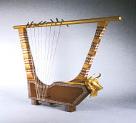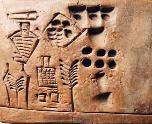| ' CHAPTER 4 ' STATE FORMATION AND PROTO-NATIONALITIES IN THE ' ANCIENT MIDDLE EAST ' SECTION A “One must not be deceived into thinking… that modernized, secularized forms of nationalism in any way represent its beginning” - Adrian Hastings, The Construction of Nationhood, 1997 (198) ' The central contention of this chapter is that people in the ancient societies at the base of western civilization tended to show a fundamentally similar succession in the bases nationality. The original basis for identity was predominantly kinship. However, groups whose members lived by herding rather than tilling crops tended to form smaller, more egalitarian groups, often extended families, which tended to migrate frequently rather than stay in one place. As mentioned in the previous chapter, there were also a substantial number of littoral-based communities, more open and less kinship-minded than agricultural-based societies. Littoral and trade-based societies, like agriculturalists, also tended to become permanently settled, as opposed to pastoral herders (see Table 3.1). ' Second, a more open, territorial basis of identity gradually replaced kinship, throughout southern Mesopotamia at least, as growing numbers of people realized the advantages of living permanently in one place. Such territorial groups might impose their own ancestral qualification for membership, as happened in ancient Athens and Sparta (Kinship-Ethnic heritage). Alternatively, as happened with early Romans (Territorial-Civic heritage), a group might offer membership to groups and persons of different ancestry who were willing and able to be of assistance in the group's struggles with rival groups. ' Finally, as territorial groups fought ruthlessly against each other, were racked by natural disasters, desertification, internal strife, further demographic pressures- or by any combination of these- many permanently settled societies began to develop a more pragmatic, if haphazard, basis of identity similar to those of primordial herding and pastoral communities. Prolonged exposure to conditions of extreme danger, accompanied often by extreme social stratification, led people to abandon loyalty to any territorial group or 'imagined community'. Instead, under such circumstances people tended to develop individual dependence upon a charismatic leader (as did the pastoral communities) or a charismatic institution (such as the priesthood), sometimes both. Such charismatic dependence (Pastoral- Collectivist heritage) often foreshadowed the conquest or disappearance of the group itself (although in the Nile oasis of Egypt, a state of charismatic dependence managed to survive for millennia; see Section 4B). ' This overall pattern (kinship-territorial-charismatic dependency) seems to us to have characterized the history of each of the groups in the early history of western civilization which are considered in chapters 4 (Sumerians, Egyptians, Hebrews) and 5 (Hittites, ancient Greeks, and Romans). Less so, it should be noted, for the ancient Greeks (who were more consistently kin-ethnicist) than the others. ' These contentions assume, as examined in the chapter 2, that a person’s identification with a group (including nations) reflects hereditary behavioral predispositions of the human species. This contention contrasts, the reader may need to be reminded, with the prevailing scholarly view that nationalism originated as an intellectual conception in Europe in the era of the French Revolution and Napoleon and spread from there to the rest of the world. Our position contrasts as well, albeit less sharply, with the modified “primordialism” set forth by Anthony D. Smith (1986), that all nationalities have sprung from an ethnically homogeneous core. ' We should also consider the contention advanced (also observed briefly in chapter 2) by Christopher Boehm in Hierarchy in the Forest (1999). Boehm contended that hierarchy in human evolution has followed a U-shaped curve. The common primate ancestors whom we share with chimpanzees lived in strongly hierarchical groups, as do chimpanzees still. Our earliest fully human ancestors, however, those who lived by hunting and gathering, were strongly egalitarian. Resenting and resisting hierarchy, they shared material goods equally and made political decisions by consensus in their small, kin-based, exogamous, and migratory groups. With the arrival of civilization, however, following by several millennia the advent of agriculture, groups tended to abandon identity based on kinship for one based on territory. Some (kinship-ethnic heritage) territorial societies attempted to maintain traditional kinship requirements for membership and citizenship much more than others. All such identities based on territory, however, tended in turn to bring social stratification, a key hallmark of civilized society, but also a characteristic similar to the dominance hierarchies so prevalent among our remote primate ancestors. When the social stratifications and related stresses became too great, the vast majority of men (in ancient times, as now) tended to give up on territorial-civic identity, and instead manifested relations of personal dependence upon an individual charismatic leader or institution. ' To recapitulate, both a kinship basis of identity and egalitarianism characterized the hunting and gathering groups leading up to the Meso-Neolithic and the eventual rise of ancient civilizations. Both kinship and egalitarian practices helped to sustain group solidarity. As people slowly abandoned a migratory for a sedentary existence, however, a more open, territorial basis of group identity often replaced kinship. Initially those societies making the transition from a kinship to a territorial basis of identity maintained some measure of their earlier egalitarian traditions. However, as populations grew and social stratification increased, territorial groups competed ruthlessly for material and military advantages. Perceived dangers proliferated as trophic and population pressures increased. Hierarchies and stress intensified with this intraspecies conflict. In these circumstances, over many generations, more and more people abandoned their national (or sovereign1) group loyalty. Instead, they began to manifest charismatic dependence upon leaders or institutions believed to possess divinely inspired or actual divine authority- not unlike the traditional leadership of herding/pastoral societies, which always had to possess the ability to adapt quickly to significant changes in their (usually drier and/or more continental) environments. In nearly all environments and ancient societies (not just the predominantly Pastoral-Collectivist), humanity reverted, as Boehm has argued, to the extremely hierarchical behavior which characterized the common ancestors we share with chimpanzees and other primates. Civilization and the Theories of State “Although it is by all odds the most far-reaching political development in human history, the origin of the state is still very imperfectly understood. Indeed, not one of the current theories of the rise of the state is entirely satisfactory. At one point or another, all of them fail.” - Robert Carneiro, 1970, (Rohrlich, 76) ' Before considering these contentions in detail we must consider definitions of both civilization and the state. Attempts to define civilization (Maisels, 1990, xv-xvi; Service, 1975; Adams, 1966) sometimes flounder almost as badly as those to define nationalism, but for our purposes a few points seem salient. Civilized societies usually have had systems of writing and have left written records that are useful in reconstructing their history. Their people have lived in groups which in comparison with earlier groups in their area usually show a greater measure of urbanization, more division of labor and concomitantly increased trade, greater social stratification, and a political organization based less on kinship and more on residence within a defined territory. However wide the disagreements on how to define civilization, there has long been general concurrence that it first appeared several millennia ago in what is now southern Iraq. Geographer Jared Diamond reminds us that the ancient Fertile Crescent- the eastern half of which consists of Mesopotamia- was naturally endowed with a greater concentration of both domesticable wild animals and plants than any other region on Earth with the advent of the Holocene era (Diamond, 1999, 410). Recent archaeological discoveries elsewhere in the Near East (Wilford, 5/23/00) have led some authorities to question whether Mesopotamian civilization really preceded all others in the region. None seem to doubt, however, that the people of this region, whether first or not, had created a civilized society with a system of writing and planning by the mid 4th millennium BCE. ' We must deal also with the origins of the state before beginning our examination of Sumerian and other ancient civilizations. For our purposes, the state may be defined simply as an organization exercising sovereign power in a particular area- i.e. supreme authority (on the use of organized force) within the territory, and freedom from all external authority. How and why did such organizations come into existence? There are three contrasting views which demand consideration. ' Anthropologist Robert L. Carneiro (1970) set forth what he called the "circumscribed land" thesis. He argued that the state originated when rival groups began to compete for possession of a limited area, or a portion of a limited area, which afforded superior prospects for agriculture; i.e. when the availability of agricultural land was restricted. An example would be a fertile river valley in an otherwise barren terrain. This is somewhat reminiscent of hyena behavior (see chapter two). When prey is widely dispersed, large groups of hyenas break up into smaller groups and indeed individuals may even forage alone. On the other hand, when prey is heavily concentrated in a limited area of lush grassland, hyenas organize into intensely competitive territorial groups. With Carneiro’s humans, as with hyenas, larger groups and improved organization aid the members in such groups to compete more effectively than they could in smaller groups. What they competed for was possession of a choice territory, or at least a portion of it, and thus better prospects for subsistence and survival, as well as (in more modern times) the cultural dominance of their particular meme. As sociologist Mathieu Deflem explains, “warfare ' arises out of a need to acquire agricultural resources, and some villages will be politically ' subjugated by other, more dominant groupings. Formerly autonomous villages thus become ' incorporated into larger political formations: chiefdoms are formed and come under the control ' of a paramount chief. Increased competition over land accelerates the process of warfare and ' political subjugation to create even greater political units (…consolidated chiefdoms). Eventually, ' when an area is sharply circumscribed [demarcated] and sufficiently large, highly centralized ' and internally differentiated states are formed” (1999, 372-73). ' Nationalities in the kinship-ethnic sense, it might be noted, have often comported easily with the circumscribed land model. Particularly in the Meso-Neolithic era of increasingly large tribes and chiefdoms, a larger chiefdom would often establish itself as a ruling elite, holding a smaller chiefdom, tribe, or village in subordinate status. Perhaps it was not unusual for all members of a group exercising dominance over another group (as Spartans later did, for example, over all their Messenian helots) to enjoy preferential access to the means of subsistence, and to whatever else group members wished. ' Moreover, the boundaries between ethnic nationalities, even today, tend to be more vigilantly maintained than are those between civic nationalities- as most travelers between western and eastern Europe could attest. ' Warfare and the occupation of subject communities have a prominent role in Morton Fried’s (1967) “Conflict” theory of state formation. He attributed the formation of states to the desire of a conquering or indigenous elite to maintain their control over people, whom the members of the elite exploit to support their privileged status. Some states- particularly ‘conquest states’ or empires- surely developed in that manner. The thesis is also compatible with dominance behavior (see chapter two), but more so as practiced by the elite class of a nationality- as conflict theories tend to focus on conflicts within a single society. According to this essentially Marxist view, states are inherently repressive- originally developed to stifle intra-societal conflict arising out of the inevitable economic inequality involved in state formation (egalitarian resentment, ala Boehm's thesis, is often a powerful motivator). Conflict theorists believe that non-state societies must either collapse to a simpler level of organization, or develop new repressive institutions in order to restrain class conflicts. It would seem that nationalities of the pastoral-collectivist heritage would be more likely to have taken shape in this manner, given their relative lack of either kinship, primeland, or volitional-pluralist factors. ' The third “integration” thesis is associated with Elman Service. He asserted in contravention of Fried that the primitive state evolved not to enable one portion of the society to exploit another, but to help in "maintaining the whole society" (Service, 1975, xiii). His view correlates well with nationality in the territorial-civic sense. In such a nationality, membership is volitional and depends upon the group providing individuals or subgroups satisfactory help in attaining goals which are important to them. His thesis is at least reminiscent of that aspect of dominance behavior (see chapter two) which fixes upon the dominant individual or group’s responsibility for protection, internal policing, and leadership. It also ties in as well with the hunter-gatherer tradition of greater cooperative and sharing behaviors. However, integration theorists would probably be unable to successfully argue for an absence of coercive conflict in the formation of the vast majority of either ancient or medieval civilizations (a great many of which were forged across formidable language barriers). ' It would appear, as Carniero noted several decades ago, that each of the schools still have major flaws, in addition to some veracity. Perhaps the theories have remained rather stagnant, yet not replaced, for so long because their explanatory power is much greater in the aggregate than it is for any one of them individually. As noted above, the circumscribed land theory of state origins comports well with the kinship-ethnic heritage of nationality, as does conflict theory with the pastoral-collectivist heritage, and integration theory with the territorial-civic. Taken together, these three theories constitute a full spectrum of state origins. ' Modern political theories of state formation also have many similarities with these anthropological theories of state origin. The circumscribed land, conflict, and integration theories of state origin (roughly corresponding to the Institutionalist, Marxist, and Pluralist schools in political science) are each correct, within its context of the three different geo-economic nationality heritages (table 4:1). Mathieu Deflem reminds us that Carneiro’s theory “reveals a clear indebtedness” to the work of late 19th century evolutionary psychologist Herbert Spencer, whereas Service’s hypothesis is “closely akin to the state theory of Max Weber” (1999, 375). Morton Fried and conflict theory, in turn, are typically regarded as a Marxist. ' The theories of state origins are also different, yet complementary in terms of time. Circumscribed land theory (Carneiro) is the only one that emphasizes the pre-chiefdom origins of state formation, when most groups were predominantly kinship-based. Deflem has noted that Service’s theory focuses more attention on “the evolutions taking place in political formations once they have [already] been established territoriality” (381), thus clearly comporting with the territorial-civic tradition. Conflict theory (Fried) has been criticized for often dwelling on points even later in the state-building process- on what might be called the post-civic transformation to expansion and empire- instead of on the earlier, “incipient phases of stratification” (Harris, 427). This chronology of state theories' foci also dovetails with the chronological trend in nationality development, from kinship-ethnic (circumscribed land), to territorial-civic (integration), to charismatic authority and dependency (conflict theory). ' Max Weber saw societies as progressing from traditional kinship organizations to legal states, but also had a third category of sorts- charismatic domination- which he saw as typically transient, apart from its role in families and religious institutions. This leads us to revisit again (see chapters 1-3) the question of charismatic authority, which has often appeared post-civic (indeed Weber saw it as an essential element in the success of legal domination), and charismatic dependency, which typically results from the failure of an CHA-justified state. State failure or CHD can either perpetuate indefinitely (as in Afghanistan), reform back into CHA (as in medieval France), or eventually lead to the reformation of new, ethno-charismatic nationalities (as in medieval Anglo-Saxon England; chapter 6). Table 4:1 Theories of State: State Origins and State Formation/Maintenance (*may not read correctly in Internet Explorer) ' Kinship-Ethnic Territorial-Civic Pastoral-Collectivist Ancient (Anthropology) Theory of Circumscribed Land Integration Conflict State Origins: (Carniero; Spencer) (Service; Weber) (Fried; Marx) ' and tribe chiefdom chiefdom multi-ethnic chiefdom/multi-ethnic empire ' its state state Original Basis: military political-religious economic Weberian traditional authority legal authority "charismatic authority"2 legitimacy: (chiefdoms) (states) (family or meme) Modern (Political Science) Theory of: Institutionalist Pluralist Marxist State Formation & Maintenance: conforming facilitating repressing in Sociology: Sociobiology Functionalism Marxism Preferred implementing inventing evaluating Thinking Style3 The Mesopotamians: Civilization Pioneers ' The claim made for Sumerians4 that they “invented” civilization, or at least urban civilization, is not merely based on the creation of a written language. They have some claim to have created in fact an amazing number of significant innovations in world history. In addition to written language are: multiplication tables, bookkeeping, city-state government, bureaucracy, professional soldiers, astrology, the six-based number system which we still use in measuring time and circumference, the seven-day week, and possibly the wheel and the plow (Crawford, 28; Leick, xvii; Redman, 269; Robson; Wilford, 11/9/93; 4/6/99). ' How they established all these things, or even most of them, still entails much dispute among authorities and leaves all too many questions about the Sumerians without definitive answers. Archeologists are not unanimous, for example, on whether they were “native” to the area between the Euphrates and the Tigris Rivers in southern Mesopotamia, or (as now seems more likely) migrated there. Those who believe they were migrants are unable to agree as to their probable point of origin, although “pre-ceramic sites" from the eastern fringe of southern Mesopotamia, circa 6500 BCE “suggest linkages” between people living in the nearby Zagros mountains of Persia and “the southern alluvium” (Kennett, 2006, 81). Their reasons for migrating, assuming as most do that Sumerians were not native to the area, are also not known with certainty (Postgate, 1992, 23-24). Early Mesopotamia, however, had been the most prosperous region of the fertile crescent for perhaps three or four millennia by the dawn of the high Sumerian (“Early Dynastic”) era of rivalrous city-states, c.3000 BCE. Moreover, the newly formed geography of southern Mesopotamia was situated in between predominantly Semitic language cultures to the west and north, and a more diverse group of Elamite/Persian and south Asian language groups to the east. One would think that the region would attract significant migrants from each of these directions over the centuries and millennia, with perhaps more of the former groups settling in the north, and more of the latter in southern Mesopotamia- as indeed the Sunni-Shiite cultural distinction in Iraq reflects even today. ' Southern Mesopotamia had been inhabited by increasingly numerous and complex hunter-gatherer bands and tribes for many millennia- and had experienced a number of climate changes- prior to the completion of the post-ice age Persian Gulf transgression (13-6000 BCE), and the beginnings of a common pottery style and mixed economy culture, c.6000 BCE (Kennett, 72, 75). ' While little is known about the earliest Mesopotamians- hunter-gatherers, proto-farmers, and pastoralists, it might be reasonable to conclude that the rich and geographically dynamic region attracted peoples from the north and east- perhaps from the Persian hills; perhaps further- whose culture and pottery in southern Mesopotamia came to be known as the Ubaid. These were alluvial and village people (there were no settlements over 1000 in population until the mid-5th millennium BCE), and the region’s only unity (besides a mixed/diverse subsistence) was in a certain style of pottery. The south was still largely littoral and hunting-gathering based as of 6000 BCE, while agriculture-based communities in the semi-arid regions of northern Mesopotamia and Syria- known as the Samarra and Halaf cultures, respectively (c.6500–c.5400)- grew denser in population. ' Douglas and James Kennett (2006) have pointed out in a cogent article how the climate of the broader fertile crescent region was vastly different in the early and mid Holocene eras that it is today. With the post-glacial thawing and gradual filling up of what is now the Persian Gulf, the “expansion and ultimate stabilization of aquatic habitats associated with the marine transgression… favored increased population densities and early group formation, community stability, enhanced maritime trade, and the emergence of social hierarchies” (Kennett, 69). Furthermore, as explained by the authors: “At 9000 ' BP, orbital perturbations of the earth were such that the perihelion occurred in July rather than January, ' as it does today, and the axial tilt of the earth was greater than it is now. As a result, July average solar ' radiation in the Northern Hemisphere was <7% higher than today (Kutzbach & Gallimore 1988; Kutzbach & ' Guetter 1986).... Increased monsoonal strength during the Early Holocene led to the higher annual precipitation ' as far north as southern Mesopotamia (Kutzbach & Gallimore 1988; Kutzbach & Guetter 1986; Roberts & Wright ' 1993; Whitney et al. 1983)… [Although] after <5500 BP, weakening of the monsoons led to increasing aridity ' over the Arabian Peninsula (Sirocko et al. 1993)” (Kennett, 79). ' While it may seem odd that the area just to the north (northern Iraq, adjacent areas of Iran, Turkey, and the eastern Mediterranean coast in general) had produced a considerably greater population for several millennia (Lamberg-Karlovsky & Sabloff, 107; Kuhrt, 12) than southern Mesopotamia, it seems that prehistoric humanity’s general preference for hunting and gathering over agriculture predominated in the south, where the littoral environment had not yet stabilized (due to alluvial formation and changes in the water table) until the mid-Holocene era. Moreover, wet (humid) conditions throughout the north and the greater Red Sea region from 7200 BCE persisted until approx. 4000 BCE, although a “gradual decrease in humidity” trend had started from as early as 6000 BCE (Kennett, 76). So agriculture and experimentation with irrigation was feasible in northern Mesopotamia, which had higher population densities5 than the south throughout the early and mid Holocene. The Kennetts remind us also that Early Holocene “climatic conditions in Arabia” were on average 3-5 times wetter (<250– 300mm annual rainfall) than today” (75-76), sufficient to sustain rain-fed agriculture, “perhaps in combination with opportunistic use of seasonally receding flood zones or the higher water tables close to the head of the Gulf (Kouchoukos 1999)” (Kennett, 82). ' Similar to the Venetians’ origins at the top of the Adriatic Sea some six-to-seven thousand years later, early Ubaid settlements at the top of the newly-formed Persian Gulf were “located on slight rises ' (turtle backs) within aquatic habitats resulting from seasonal monsoonal rains or in the wetlands at the ' head of the Arabo-Persian Gulf as sea-level rise slowed (Pournelle 2003). Such locations were at the interface ' between fresh and salt water and were optimal for fresh water accessibility, hunting/fishing, transportation, ' and irrigation agriculture (Oates 1960). Within this aquatic context, a broad-spectrum economy developed ' during the Ubaid Period, based upon small-scale agriculture with an emphasis on salt-tolerant crops, animal ' (e.g., oxen) domestication, hunting, fishing, and trade (Huot 1989; Sanlaville 1989; Woolley 1929:14)” ' (Kennett, 82). ' Ubaid mortuary studies “provide little evidence for social ranking and depictions of rulers are rare (Stein 1994; Wright & Pollock 1986),” despite the coastal settlements of Eridu and Ur having grown to 2,000-3,000 people by the middle Ubaid era (Kennett, 83, 82). Nonetheless, intensified agricultural production was necessary in order to sustain increasing populations, and by the end of the Ubaid Period (c.4300 BCE), “some communities were substantially larger than their neighbors, were ruled by hereditary leaders, and were administered by institutionalized administrative organizations” (Kennett, 83). In the mid 5th millennium, this expanding Ubaid culture(s) appears to have “replaced” Halaf culture in the Zagros mountains and the north (Van De Mieroop, 2004, 15). Perhaps this constitutes an early example of a littoral (territorial-civic) culture expanding at the expense of kin-based agri-dependent groups. ' By this era of the Ubaid-Uruk transition, c.4300 BCE, land was being increasingly circumscribed, due to both higher populations and the earlier stages of the aridity trend. These changing conditions favored “population aggregation, and intensified agricultural production, economic specialization, and the formation of social and political hierarchies founded on and reinforced by new or existing ideological systems… the first urban centers emerged and controlled adjacent communities with elaborate and centralized administrative hierarchies led by a small, elite class” (Kennett, 85). Population growth seems to have been driven both by indigenous increase and by immigration. Arye Issar and Mattanyah Zohar point out that Mesopotamia was “exposed to its neighboring countries and continuously had to confront and often absorb outsiders from the surrounding mountains or semi- deserts” (2004, 108). ' “In addition to the aboriginal fishermen dwelling in the swamps and related with the Halafian ' culture further north, the basic population were the farmers and horticulturalists from the foothills ' of the Fertile Crescent probably speaking Sumerian. During the cold periods, people arrived from ' the northern highlands, bringing metallurgy skills, as well as relations with the people of the ' metalliferous provinces. The arid periods… saw the immigration of pastoralists speaking Semitic ' Proto-Akkadian from the east and west, with their proficiency in dairy and wool production” ' (Issar & Zoyhar, 108-09). ' There is still some contention as to when southern Mesopotamia first became ‘Sumerian’, but archaeologist Hans Nissen asserts, reasonably, that “If there is any moment in time to which we can assign the arrival of the Sumerians with a high degree of probability, it is this…[Late Uruk, latter 4th millnium BCE] first period of settlements in large areas of the southern Babylonian plain… Even though by this time the water had receded so much that the land had become habitable, there was nonetheless for some considerable time so much water still available that nearly every arable plot had easy and direct access to it” (1988, 69). This liberality of the 4th millennium south Mesopotamian environment argues for Service's integration theory of state formation for the region (Table 4.1, above). The emergence of the Uruk, or proto-Sumerian, urban culture as early as c.3800 BCE marked, in the words of anthropologist Guillermo Algaze (2001), “a veritable revolution in human social and spatial organization,” based on material advantages and an “exponentially more efficient distribution system based on water transport” (200). Such developments were motivated at least in part by a large influx of foreign migrants in the mid 4th millennium, of whom not much is known, apart from the newcomers’ role in fueling urbanism and the construction of temples. This initial urbanization in world history was also motivated by geographic factors. Agricultural yields were increased three-fold with irrigation, and were perhaps twice as high on the southern alluvial plain as in the dry-farmed and rain-fed north (201-02), as summer monsoonal rains still landed on a southern Mesopotamian alluvium that today receives no summer precipitation whatsoever (Algaze, 203). Souther Mesopotamia was catching up with the north in terms of population. ' Still two more geographic considerations may help explain why the Uruk period proto-Sumerians became so successful. The terrain in southern Mesopotamia is very flat. Some 500 kilometers from the Persian Gulf the elevation on the Euphrates is only some twenty meters above sea level (Postgate, 6). Important consequences resulted from this elemental fact. The Euphrates moves slowly, changes course often, floods frequently, and leaves deposits of silt, which greatly enhance the productivity of the soil. The flat terrain made diversion of river water for irrigation relatively simple. Furthermore, the Euphrates in particular tended, even in its natural flow, to deposit silt along its banks. This in time created natural levees so that the river at times actually flowed above the level of the adjacent ground, thus facilitating still more the use of its water for irrigation (Postgate, 174). Clearly nature had endowed the Sumerians generously in these respects, but only if they were able to exploit the opportunities to irrigate potential cropland. Compounding the south’s comparative advantage in irrigation and productivity was the fact that northern areas had suffered soil exhaustion from thousands of years of farming, as most areas lacked the frequent flooding and the resulting silt deposits which in southern Mesopotamia kept soil productivity very high. ' Mesopotamian economic history tends to be more decipherable than the region’s cultural history. In terms of language, historian Marc Van de Mieroop explains that, by the Sumerian city-state era, one “can state with certainty that at least two languages were spoken in Babylonia… Sumerian and a ' Semitic language sometimes referred to as proto-Akkadian… the same groups of people used ' them simultaneously. It is not easy to determine someone’s spoken language in a multicultural ' ancient society. All literate Mesopotamians in this period (or Near Easterners for that matter) ' shared the same scribal culture… Although they could, and did, write their own vernaculars, all ' were able to write Sumerian. A text written in Sumerian is thus not evidence that the writer’s mother ' tongue was Sumerian… the names of people are probably a better indicator of the language they ' spoke. In the ancient Near East, people’s names were often short sentences… and so give an indication ' of their family’s familiarity with a language… we see… a mixture of Sumerian and Semitic names, the ' former predominant in the south of Babylonia, the latter in the north. This distinction did not lead to ethnic ' conflict, as has sometimes been argued. Members of the two linguistic groups lived side-by-side” ' (2004, 49-50). ' It also seems likely that spoken Sumerian had dialects and was not uniform throughout Mesopotamia. The fact that the written language changed “rather abruptly” to Akkadian in the Sargon era (c.2300 BCE), anthropologist Susan Pollock points out, makes it appear that spoken Sumerian fell out of usage considerably earlier (1999, 167-68); perhaps due to earlier waves of migration from surrounding pastoralists, most of whom spoke Semitic languages. ' Whether language was ever a unifying factor or not, the people of Sumeria (c.3000-1200 BCE) certainly did not consider their cultures uniform. By this time the Mesopotamian world was a patchwork of rival groups, some 30 independent city-states, each with its own patron deity- reminiscent of the sovereign city states of early medieval Italy with their patron saints, nearly five millennia later. Nissen has found that, c.3000-2560 (the Early Dynastic II period), “the custom of setting up statues in temples” with the intention of idolatry began (1988, 155). As he explains, the “notion of a god that makes it ' conceivable that the god can be influenced in this way differs fundamentally from one that sees in the god ' only what is spiritually elevated. It is a humanization of the divine image such as we have already seen as a ' precondition for the theological speculations about a pantheon… expressed in the form of family relationships. ' The astonishing thing is that it was not merely members of the upper class in a particular place who donated ' statues, for the finds are from small shrines in normal residential areas… this period quite clearly enjoyed a ' great demand for artists as well as for raw materials” (Nissen, 155). ' Such religious decentralization had led, by at least the early second millennium to a tradition of the courts “portraying the king in superhuman terms” (de Mieroop, 2004, 109). Pollock reminds us that by this time writing, too, had “begun to be used for a much wider range of purposes than just recording economic transactions”, including myths, hymns, incantations, and dedications, despite literacy “being limited almost exclusively to scribes” (Pollock, 168). These diverse city gods performed key roles in economics as well, as Thorkild Jacobsen observed: “in the south” city gods were “closely related to marsh life and its primary economies, fishing and hunting… [while] Along the lower Euphrates deities of orchardmen alternate with deities of cowherders” (1976, 25). And in the “cities of farmers” of the north and east, the wind god, grain goddesses, and god of thundershowers and the plow predominated in the oldest Sumerian cities (Pollock, 25). While religious democratization may sound like a civic development at first, the lack of any barriers between church and state often weakens the former, while increasing the totality (charismatic authoritarianism) of the latter. Sumerian priests, as was usual throughout antiquity, appear never to have unsubordinated themselves from state service, regardless of how large or petty the states were. ' Nonetheless, the religious experimentation of the many Sumerian city-states appears to have yielded results over the long-term that must be described as impressive. “Sumerian cosmological notions which may have been the source of all later Mesopotamian mythology as well as of much of the Indo-Iranian, indeed recur in the Hurrian myths which were preserved in the Hittite kingdom” of modern- day Turkey (Jacob, 99). The seven gods (Anunnaki) of Sumeria are also “the prototypes of the Adityas of Indian mythology,” according to Alexander Jacob (1999, 101). Like the morality of the Sumerians and the Egyptians, the morality of the original Indo-Europeans, too “is solidly based on the original cosmic and moral harmony of the universe, a harmony which cannot be disturbed without dire consequences for the transgressor of the divine law” (111). Thus “the cosmos in the Indo-European mythology is understood simultaneously as a moral phenomenon as well as a physical one. It is this fact, above all, which should be considered as the distinguishing characteristic par excellence of the ancient Near Eastern religions, Sumerian, Egyptian, and Indo-Aryan” (Jacob, 103). ' To what extent writing was driven by urbanization, or urbanization was driven by writing is difficult to gauge. What is clear, however, is that, from at least the Early Dynastic Period (c.3000 BCE), the south constituted the “intellectual center” of Mesopotamia, “where scribal practices and most literary texts were first produced” (Van de Mieroop, 57). Syria and northern Mesopotamia were urbanized with the “adoption of scribal practices from the south” (56), and it appears that the basis of ideological power in the north “was secular rather than religious” (52). Maisels concurs that it was in the “’deep south’ of the alluvium, where the earliest pioneers established the first true cities” (Maisels, 1999, 163). Temple “domains were most prevalent in the far south and in the lower section of the near south… Their importance was markedly less in places located farther north… decreasing even further in northern Babylonia, where the dominant forms of economic organization were the royal and private households” (162). Mesopotamian cultural influence was not unilateral, as “private property in land was a fundamental northern characteristic that spread through the south”, c.2500-2000 (Maisels, 162). Table 4:2: Introducing South Mesopotamian Cultures: Pre-Ubaid to Sumer Time: 14-6 BCE 6.0-c.4.3 BCE 4.3-3.0 BCE 3-2 BCE Cultural Complex Hunter- Ubaid Uruk Period Sumerian/Dynastic Era: Gatherers6 (common culture) (indep. polities) (rivalrous city-states) Climate & humid/semi-arid; rain-fed agriculture; aridity & urbanization; further aridity & Geography: rising gulf/water dynamic coasts/floods; but high water table; urbanization; ' table; monsoon; some irrigation & extensive irrigation; sedimentation & ' lakes; north uniform pottery; north coastal Eridu & Ur; salinization; dependent ' more populous technology advantage fishing & farming on southern irrigation Southern complex hunter Ubaid 'mixed temples & trade; literary writing; Core: gatherers economy'/traders scribe culture cosmopolitan/pluralism Northern more populous; Halaf & Samarra private property; Akkadian territorial Periphery: pastoral/ farming agriculturalists less pop. than south state Nationality kinship-based kin-ethnic?7 territorial?; charismatic authority Basis: increasing villages & small small cities; increased urban city-states ' settlement towns common trade & luxury goods Theory of n/a Integrative; Circumscribed Land; Conflict; State: low social hierarchy strong hierarchies inland (Nippur/Enil) ' and warfare; and division of labor; & religious focus; ' temple leadership supreme relig. elite; deified rulers norm; ' incr. competition; walls walled cities norm Kinship and Ethnic Bases for Identity ' We shall use the term kinship group to apply to the small groups of egalitarian and migratory extended families, which were typical among people who lived primarily either by herding or by modified hunting and gathering. No evidence that we are aware of indicates clearly that the earliest settlers of southern Mesopotamia were mostly organized along such lines, although it seems likely that farming and herding coexisted with hunting and gathering for some time- particularly further south in the littoral region, which was rich in wildlife and fish. It does seem clear that early settlers’ migratory background and the residue of egalitarian traditions that they observed for some time (see below) make an assumption of extended kin groups appear warranted. ' Proto-sumerians also had all the elements which define a nationality in the modern ethnic sense. Their ancestors were probably (for the most part) an even less known people, the Ubaids, who appear likely to have migrated from the highlands to the north and east. The Ubaid culture left small, scattered, and relatively uniform settlements scattered along rivers over the entire alluvium littoral, c.5500-4000 BCE. The most compelling evidence linking Sumerians to the Ubaids is the temple at Eridu ("Good City"), apparently proto-Sumerians’ first settlement, c.4100 BCE- some 15 centuries after its purported original settlement by the Ubaids. Excavations reveal that Eridu had been rebuilt and enlarged many times over many centuries by pious descendants (Leick, 29; Yoffee, 1993, passim; Roux, 2001, passim; Lamberg-Karlofsy, 110; Maisels, 154, 304; Postgate, 24, 34). ' Were there hereditary physical characteristics distinctive to the Ubaids and their Sumerian successors? As late as the mid-20th century, authorities seemed to think so, but the established view has changed since then. As historian Michael Rice explains, the ancient Sumerians themselves “have not helped the matter by tending, throughout their history, to portray themselves as rather tubby, short- necked, round-headed people.… But linguistic distinctions do not reveal themselves in skeletal remains: a Sumerian urban skeleton is indistinguishable from one of a Semitic-speaking desert-dweller" (1994, 94). So Sumerians of the High Dynastic era (often living in linguistically intermixed communities) were at least well-aware of their historical ethnic distinctiveness, even if the number of skeletons unearthed in the modern era would not appear to support their assertions. Further suggesting awareness of an ethnic basis of identity, Sumerians also called themselves “people of The Land”- meaning those residing in the rather small area of “the southern Mesopotamian alluvial plain…”8 (Postgate, 1995, 398-399). Further indicative of deep kin-ethnic-based rivalries is that fact that no political unit encompassed all the people of “The Land,” until Sargon, a speaker of the Akkadian Semitic language, imposed his rule upon them, c.2300 BCE. Enduring political unification, moreover, was not established until the Persian conquest, c.540 BCE (Baines & Yoffee, 1998, 204). ' This refusal of the Sumerians to achieve enduring political unification by their own effort appears all the more remarkable because language and religion as well as ancestry set them apart from neighboring groups. The Sumerian language is clearly unique. Not only is it quite distinct from the various Semitic languages which were numerous in the area, but even differs substantially from what little we know of Ubaid. It is also not within the family of any known language, with the possible exception of the vast Ural-Altai language group9. Thus it would presumably have created an important bond among the Sumerian people, one which differentiated them from so many of their neighbors who spoke Semitic or Elamo-Dravidian languages. ' Sumerian religious precocity, perhaps motivated by the high diversity of the Mesopotamian alluvium, led to the centering of their settlements around city temples, whose priests appear to have taken crucially important roles for many centuries in directing the affairs of their communities. Each Sumerian community, it is true, had its own local deity, but they were often joined loosely in a pantheon, in which the temple at cosmopolitian Eridu (which was at one time a coastal port) enjoyed some primacy in the Ubaid and Uruk eras. By 2700-2500, however, the inland city of Nippur, purported residence of the storm god- Enlil, assumed superior religious authority (Leick, 2001, 146 ff). This shift from a predominantly southern/coastal to northern/interior culture probably appeared sometime in the upper 3rd millenium, when aridification and other environmental changes were affecting the heavily irrigated south. Patrick Kirch reminds us that so much salinization had occurred in the south by 2400-1700 that a shift had to be made “from wheat to more salt-tolerant barley. Even barley yields declined progressively, however, as indicated by temple records showing a drop from… 29 bushels per acre around 2400 B.C. to as low as 10 bushels per acre by 1700 B.C.” (2005, 427). ' The Sumerians appear to have had, despite their later environmental stresses, all the features which modern ethnic nationalists cite as warranting a unified, sovereign government. Yet the evidence indicates that they never saw their commonalities in ancestry, language and religion as sufficient basis for voluntary union. They seem to have come into the southern Mesopotamian alluvium organized in small, egalitarian groups of extended families who had lived previously by hunting and gathering, herding, or a mixed subsistence. Once settled in the Mesopotamian alluvium they organized themselves into what would become a tradition of intensely competitive city-states. Perhaps it was the lack of a clear and present external military threat- taken for granted by the latter ancient, the medieval, and modern eras of history- that allowed such a decentralized patchwork of sovereign city- states to carry on, prior to the advent of the Akkadian empire. ' Further back in the Ubaid era, national unification and/or rivalry appears to have been not much of an issue, as long as there was trade. And by the time they were sufficiently populous to become urbanized in the later Uruk era, ‘Sumerians,’ or Sumerian language speakers, could well have been a minority group within much of what we traditionally assume to be ‘their’ lands. Kinship and ethnic factors appear increasingly marginalized in southern Mesopotamia after the Ubaid era, due primarily to the long tradition of migration and urban concentration throughout the Uruk and Early Dynastic eras. During the less populous and simpler Ubaid era, however, it seems safe to conclude that Mesopotamian nationalities were primarily kinship-based- albeit a more broad and open kinship in the alluvial/coastal south, and a more narrow kinship in the dry-farmed lands of northern Mesopotamia. Harriet Crawford reminds us that the “earliest records” concerning Sumer’s northern neighbor Akkad, reveal that arable land there was “held by families rather than by individuals and all male members of the family had to give their consent to a sale (Diakonoff 1982; Gelb et al, 1991)” (2004, 32). |
Ch.4- Sect.B- Egypt and Canaan
pp. 205-237
pp. 205-237
1 by 'national group' in the prehistoric and ancient eras, we
mean the largest or politically sovereign 'imagined
community' with which people were members and could
identify with (be it a tribe, confederation, village, or
commune, city-state, etc.)
mean the largest or politically sovereign 'imagined
community' with which people were members and could
identify with (be it a tribe, confederation, village, or
commune, city-state, etc.)
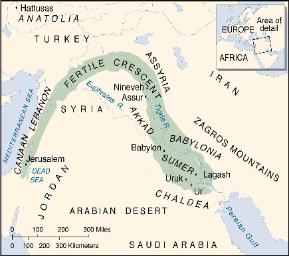
linguo-ethnicity
3 from Sternberg, Robert J.; O'Hara, Linda A.; and Lubart,
Todd, I. (2000). "Creativity as an Investment" In Osland,
Kolb, and Rubin, eds. The Organizational Behavior Reader
(7th ed., Upper Saddle River, NJ: Prentice Hall, 594 pp.)
Todd, I. (2000). "Creativity as an Investment" In Osland,
Kolb, and Rubin, eds. The Organizational Behavior Reader
(7th ed., Upper Saddle River, NJ: Prentice Hall, 594 pp.)
2 Weber noted that 'charismatic authority', like 'traditional
authority', lead inevitably to a more structured form of
authority, with the 'rational' or legal authority typical of
western capitalism representing the most developed or
"routinized" form of domination (Bendix, 1977). Hence, his
theory of state stops with the development of rational-legal
authority. And 'charismatic authority', for Weber, was
(beyond the familial and religious spheres) only a temporary
or transitional state of affairs, on the way towards either
'traditional' or 'legal' authority. The relatively short-term
'charismatic authority' of the Nazi 'thousand year Reich'
(actually only 12) in 20th century Germany seems to support
Weber's theory. We, however, see lasting charismatic
authority-justified states (perhaps Weber would have simply
called them 'traditionally' justified; a catch-all category in
his scheme that conflates kinship-based and multi-ethnic
authoritarian societies) in Ancient Egypt and other
multi-cultural, absolutist regimes.
authority', lead inevitably to a more structured form of
authority, with the 'rational' or legal authority typical of
western capitalism representing the most developed or
"routinized" form of domination (Bendix, 1977). Hence, his
theory of state stops with the development of rational-legal
authority. And 'charismatic authority', for Weber, was
(beyond the familial and religious spheres) only a temporary
or transitional state of affairs, on the way towards either
'traditional' or 'legal' authority. The relatively short-term
'charismatic authority' of the Nazi 'thousand year Reich'
(actually only 12) in 20th century Germany seems to support
Weber's theory. We, however, see lasting charismatic
authority-justified states (perhaps Weber would have simply
called them 'traditionally' justified; a catch-all category in
his scheme that conflates kinship-based and multi-ethnic
authoritarian societies) in Ancient Egypt and other
multi-cultural, absolutist regimes.
First Extenive Agriculture
...and Horses
5 Prehistorian Steven Mithin reminds us, however, that the
greater population densities of the north probably predated
the development of irrigation farming. "By 5000 BC
substantial towns are found throughout... [almost all] of the
Fertile Crescent"; and around the Tigris and Euphrates, the
merging Hassuna and Samarra cultures show sings of
raising cattle, in addition to the "pre-eminent" sheep and
goats: "As the addition of rich milk fats to human diets can
increase the birth rate, cattle herding may have been a
factor behind what appears to have been a population
explosion" (Mithen, 2004, 439).
greater population densities of the north probably predated
the development of irrigation farming. "By 5000 BC
substantial towns are found throughout... [almost all] of the
Fertile Crescent"; and around the Tigris and Euphrates, the
merging Hassuna and Samarra cultures show sings of
raising cattle, in addition to the "pre-eminent" sheep and
goats: "As the addition of rich milk fats to human diets can
increase the birth rate, cattle herding may have been a
factor behind what appears to have been a population
explosion" (Mithen, 2004, 439).
From Kinship to a Territorial Basis of Identity ' A territorial-civic nationality, as mentioned in the previous chapter, has more open/liberal group membership and citizenship than its kinship-ethnic based contemporaries. The early Sumerian city states, particularly in the more cosmopolitan southern littoral region, were no exception to this. The Kennetts remind us again that, particularly in ancient times, water transport significantly expedited the effectiveness and speed of trade. Probably because of this trade factor, as far back as the Ubaid Period, “communities in the Eridu and Tell Oueli [coastal] regions became increasingly maritime (Huot 1989). Even the later Sumerians (<4500 BP) are considered to have been a maritime culture (Falkenstein 1951; Jacobsen 1960)” (Kennett, 2006, 89). The heritage of fishing and farming from the Ubaid era also provided a “powerful economic engine for population expansion,” while trade journeys to distant ports “facilitated the exchange of ideas and provided exotic goods consumed by emerging elites” (89). Thus did large towns and cities arise, first in smaller communities in the hundreds, but with populations into the thousands and eventually tens of thousands by the Uruk period. ' Indeed the word city was coined in the middle ages from the Latin civitatem- "citizenship, community of citizens,” in turn a derivative from civis, or "townsman." Urban planning professor Edward Soja reminds us that the Sumerian harbor city of Ur (just northeast of old Eridu) pioneered “new relations of production rooted in private property, [and] land ownership,” as well as in “patriarchy, and the formation of hierarchically organized social classes” (2000, 60). Such urban class formation “was ' based initially on a stratification of prestige and empowerment that arose largely from real or putative ' kinship ties to key ancestral figures… Over time and space, these differentiated kinship ties took on ' more formalized religious…significance and symbolism that tightly integrated the polity… [But] a key ' difference in governmentality that would arise in the Sumerian city-state was the development of a distinctive ' and autonomous civic sphere. Urban governance, the development of the urban economy, and the social ' production of cityspace, even with the continuation of divine kingship, became more secular and specialized, ' and increasingly self-generating and autonomous… At first, the top of the new urban social hierarchy at Ur ' and other Mesopotamian city-states consisted of a divine sovereign, king and/or queen, and an associated ' cadre of priest and priestess counselors and scribes serving as a ruling elite over a population consisting ' primarily of farmers and a small but growing group of artisans, merchants, soldiers, and civil servants. By... ' 2500-1500 B.C., however, Ur had developed a more specialized and expanded administrative, religious, and ' economic bureaucracy; and the royal leadership became both more secular and, it would seem, more ' dominantly male-centered… reflecting the intensifying patriarchy that grew in close association with class ' formation” (Soja, 60-61). ' Thus was the path of what has long been seen as the world’s earliest pioneer of civilization. Meeting the threats of both increasing aridity and foreign immigration, proto-Sumerians devised the ideologies and state structures necessary to consolidate labor for the large-scale irrigation works required to survive the drying. The resultant Sumerian civilization not only survived but thrived, establishing their significance by collectively making an unsurpassed number of cardinal innovations in world history- some “39 Firsts,” according to Assyriologist Samuel Noah Kramer (1989). It is clear that, at their high point, each Sumerian city had a strong territorial basis of identity, strong enough (as would later prove the case with certain European city-states in the medieval era) to maintain their sovereignty over a number of centuries. Historian Muchou Pu points out, moreover, that from c.3100-2350 BCE (the High Dynastic Era) there was “hardly any indication…that ethnolinguistic difference was the cause of conflict between the early city states”- most of which encompassed both Sumerian and Akkadian speaking populations- since the primary sources do not even mention “the ethnolinguistic affiliation of either enemies or allies” (2005, 30). It appears that early Sumer provides us with the first example of how a relatively open (and littoral-based) kinship basis of identity can lead directly to the formation of a more open, territorial identity-based nationality. There appear to be no contrary signs indicating discrimination or in-group/out-group bias against Semitic language speakers. Indeed, the Sumerian languages seems not to have had a word for 'foreigners' (Maisels, 1990; cf Lamberg, 159). ' The lack of pan-Sumerian solidarity, however, appears to have increasingly posed a problem to maintaining traditional sovereignties. The city-states were intensely competitive, fighting each other almost constantly. In addition, they often faced threats from neighbors in the mountains to the north and east, as well as from desert pastoralists. Furthermore, the degree of both material and political inequality in Sumerian cities increasingly put solidarity in some doubt, especially in the later period of (even more) adverse environmental changes. ' We look first at material equality. Anthropologists seem to agree (see chapter 2) that nomadic hunter-gatherers were strongly egalitarian. Both the Ubaids and proto-Sumerians seem to have retained a significant measure of this egalitarian heritage for some time after they or their ancestors gave up nomadic hunting and gathering as a means of seeking subsistence. Their societies at first showed little interfamilial difference with reference to material possessions (Charvat, 76; Matthews, 2003, 107-108; Frankfort, 1951, 59; Leick, 46, 50; Kennett, 83). ' Social stratification, however, is a major hallmark of civilized society. Anthropologists insist on this point. They also find that the organization of “state” societies tends to increase it (Redman, 277; Larsen,174). Consequently, it is unsurprising that civilized Sumerian city-states showed increasing differences in material well-being. By 2000 BCE, Lamberg-Karlovsky and Sabloff (1979, 175) found what they called an ever-aggrandizing nobility of administrators, merchants, and priests had achieved far greater wealth than ordinary farmers or artisans, who in turn had far more wealth than the small class of slaves. Slaves were generally women and children captured in war, but by that time merely being in debt could also lead to enslavement. Parents could also sell children into slavery (Mann, 87; Kramer, 75). As Michael Mann observed, the “emergence of stratification and the state was slow and uneven” (1986, 87). It was also inexorable10, however, and one may suspect that it eventually grew to undermine the solidarity of Sumerian identity. ' Political equality is a more difficult topic. Abandoning an ancestral for a territorial basis of identity occurs frequently when a previously nomadic people decide to settle down. We know little about possible nomadism among the earliest Sumerians or their Ubaid era predecessors, but we do know that: a) the region they came to inhabit was previously without significant settlement, that b) their settlements in southern Mesopotamia developed into some of the world’s earliest cities, and that c) in each of these communities, Sumerians developed an intense identification with their own city. Thus it seems reasonable to presume that perhaps some late Ubaids and certainly Uruk-era Mesopotamians abandoned a kinship basis of identity for one based on the territory of their residence. We know also that non-Sumerians were present in such ‘Sumerian’ communities from the earliest times- hardly surprising, given southern Mesopotamia’s enduring prosperity. We do not know with certainty, however, whether or not such outsiders were often accorded political status equal to that of Sumerians. No evidence that we have seen bars conclusively the possibility that Sumerian cities imposed an ancestral qualification for citizenship analogous to that imposed by major city states in ancient Greece (see chapter 5). Like Sumerians, the Greeks would split into intensely competitive city states despite their (probably greater) commonalities in ancestry, language, and religion. Among these city-states, Athens, for example, limited citizenship, with rare exceptions, to those whose parents were both native Athenians (Arnheim, 163). Much of the limited evidence relating to Sumerian city-states suggests that in fact they did not impose such restrictions, and indeed may not have bothered to record ethnolingustic distinctions. But the available evidence appears too limited for a firm conclusion as to whether or not Sumerians ever imposed a lasting ancestral qualification for membership or citizenship in their tightly bonded urban communities. Perhaps the more cosmopolitan southern city states, with their more littoral and trade-based economies, were more liberal in regards to citizenship than the north. ' Most authorities (e.g. Diakonoff, 1991, 72; Yoffee, 1993, 260) seem agreed, as noted above, that non-Sumerian people were present in ‘Sumerian’ communities from the outset. To reiterate, this should not be unexpected, as Mesopotamian trade lines through the Persian Gulf to India and northeast Africa had been established as far back as 5000 BCE (Soja, 60). Yet Sumerians apparently had no word for foreigner (Maisels, 1990; cf Lamberg, 159). Nomads of Semitic ethnicity often settled among the Sumerians, sometimes as mercenaries, but were seemingly “absorbed” (Postgate, 85). Some Sumerian scribes (the tiny minority who apparently invented writing and kept records) bore Semitic names (Potts, 212; cf. Nissen, 1988, 138). No one has found significant evidence of ethnic stratification or even discrimination. Indeed Samuel Kramer insisted that Sumerian culture was, from the outset, a blend of Ubaid settlers and Semitic nomads from the west- who increased in number and influence over the many centuries of the Ubaid era (Kramer, Ch. 2). A related view holds that later Sumerians were in fact “an amalgam of various elements melted together” (Bottero, 17). Still another, however, states adamantly that Sumerians were not from a “common gene-pool” (Mann, 92). Even clans are only rarely referred to in administrative documents, although such references do appear occasionally in literary texts (Greengus, 1995, 469; Postgate, 80-83). Van de Mieroop explains that the term clan was “extremely rare…and can also be interpreted as a purely geographical designation ' without any reference to family ties. It is clear… that family members did not live as neighbors, with few ' exceptions. Upon the death of their father, brothers commonly divided the paternal home, and sometimes ' resided together with their individual families, but had no objections to selling off their part of the house and '' moving elsewhere… neighbours were not usually related by blood, and… people act primarily as individuals, ' not [as would be later in Venice] as members of extended family communities… It seems…false to assume ' from later Islamic parallels that village communities or tribal groups that moved into towns maintained their ' strong family ties and resided in the same neighborhoods. All ancient Mesopotamian textual evidence at our ' disposal contradicts such a conclusion” (Van de Mieroop, 1997, 105-06). ' There are more dissenting voices. Near Eastern anthropologist Norman Yoffee has asserted, albeit without specific support, that “ethnic and kin-groups” had an important role in “early Mesopotamian social life” (1995, 303). Andean anthropologist Terence N. D’Altroy concurs that “kinship ideology”, as in Latin America, had a “key role” in the “power structure of early Mesopotamia….” (D’Altroy, 2001, 456). Perhaps (as was also typically the case in ancient China and other multiethnic societies) kinship and clans were important to the ruling elite and top political structure of society, but largely irrelevant to the overwhelming majority of common folk. ' Sumerian cities of the third millennium, unlike China, had what appear to be democratic institutions of government. Cities generally had an “assembly” of uncertain composition which held considerable power. So too did a “Council of Elders” of similarly uncertain composition. Thorkild Jacobsen speculated on the basis of much later documents that these were two houses of a bicameral legislature, but no one has either proved or disproved his speculation (Jacobsen, 1943, 1976); as no assembly houses have yet been unearthed. I.M. Diakonoff, however, agreed, distinguishing “a council of elders representing the estate owning community” from the gurus of the assembly, “representing the common members of the community, those who cultivated small family plots” (Katz, 1993, 23). Some five millennia before Thomas Jefferson, both institutions “shared power with the ruler,” at least “in matters other than the affairs of the temple estates, irrigation and building programs” (23). More recently, Maisels (1999) has conjectured that the Elders’ Council “was the more or less permanent city government, and that ‘juniors’ were admitted to form an Assembly when assent was wanted for decisions of the Elders’ Council. This Assembly would accordingly comprise… the ‘small and the great’ (literally young and old)” (Maisels, 169-70). One of the many legends of Gilgamesh, the fifth King of Uruk, c.2700 BCE, was that he “tried to mobilized the citizens of Uruk” for warfare against the overlordship of the northern city-state of Kish. Refused by the Elders, Gilgamesh “appealed to a ‘general assembly’ to overturn their decision. In this sense, city-state government was consensual”; or at least up until that time. Gilgamesh’s actions were viewed as “effectively conducting a coup d’etat” (Maisels, 170). ' Neither, either, or both of these institutions may have had an ancestral or ethnic qualification for membership; or perhaps merely residential or professional; or any combination of these. Van de Mieroop reminds us that ancient Mesopotamian cities were “made up of various groups, which could be familial, ethnic, residential, or professional in nature. An individual outside any of these groups did not have a means to participate in the social and political life of the town” (1997, 257). Diakonoff thought kinship ties in time proved insufficient to sustain unity, and as such ties loosened, “relations based on residence or ties formed simply on the basis of being neighbors became dominant” (Diakonoff, 1991, 34-35). His conclusion seems highly plausible, particularly within the context of urbanization, but evidence that residential criteria for group membership largely replaced ancestral qualifications is still inconclusive. ' There does seem evidence to support, however, a general long-term trend in the broader region- among the vast majority of commoners at least- away from kinship and ethnicity. Van de Mieroop has noted that the ethnic groups in Old Babylonia (upper 2nd millennium BCE) “assimilated over the years” and “lost their separate identities, at least until the arrival of the Greeks” (1997, 115). Moreover, “members of multi-lingual societies of Mesopotamia did not seem to have been averse to using a different language to name their children,” and when a nuclear family migrated to the city, “it seems to have abandoned its existing ties very quickly. The extended families of village communities or tribes do not seem to have survived, while a separate ethnic identity was maintained for only a few generations,” as professional associations and social class became more important than kin (115). If the sovereign city-state of medieval Venice is to serve as any guide in making conjectures unto the ancient sovereign city states of Sumer, then it could be expected that pre-state/primordial kinship ties gave way via the process of urbanization to more residential and professional civic bonds. But that, as the centuries wore on, the hereditary aristocracy of the city state began to reassert kinship and increasingly emphasize elite pedigree in eligibility for positions of responsibility in the community. ' Religion also raises doubts about the degree of political equality in early Mesopotamia. Priests surely drew considerable authority from the presumption that they spoke for the city god, for whom all city residents (by the Early Dynastic Era at least) were seen as servants. Precisely how priests exercised this authority is not at all clear (Diakonoff, 33). However, it seems reasonable to suppose that they had administrative responsibility for numerous communal undertakings. Each city had to construct and maintain the network of irrigation canals and reservoirs required to realize the high potential productivity of their alluvial soils. The fact that flooding coincided usually with harvest time in the spring, while water for irrigation was most needed in later seasons underscores the importance of these communal labors. They needed both to prevent flood damage at harvest time and to store water for considerably later use (Mann, 86; Diakonoff, 32-33; Postgate, 1992, 178; Redman, 275; Crawford, 1991, 43). ' Unfortunately surviving records provide little evidence as to the role temple priests took in such activities. Most authorities seem to think that villagers did most of this work on their own (Postgate, 109, 178; Mann, 86, 89, 96; Diakonoff, 32). However, major cities depended on canals for their supply of water, and for transportation, as well as irrigation. In at least one city a canal harbor provided a major marketplace. Furthermore some canals flowed from the higher Euphrates to the lower Tigris. That villagers did such crucially important and extensive work without supervision, direction, or at least coordination strains credulity (cf Stone, 1995, 238-240; Eyre, 1995, 180). Perhaps the role of priests in pre-dynastic Mesopotamia was at least somewhat analagous to, again, 7th century early Venice- where priests exercised leadership in organizing community labors against the forces of nature; and in the process building territorial solidarity. ' Evidence seems to indicate that a territorial basis of identity prevailed in Sumerian towns and cities in their early years- prior to the Uruk decline and ensuing Early Dynastic Era. There is no question that residents identified strongly with their own city in its competitive relationship with outsiders. Inequality in a material context during the early years seemed insufficient to jeopardize civic solidarity. The authority of both the assembly and the council of elders appears to indicate that political equality was also sufficient to preserve solidarity in the Early Dynastic Era, despite the power presumably exercised by priests and the hereditary aristocracy (Leick, 46, 50; Postgte, 301; Matthews, 2003, 107-108). From Territorial Identity to Charismatic Authority & Dependency ' To explain how Sumerian society evolved from cities with a seemingly strong sense of territorial identity and some semblance of democratic accountability to an empire ruled by a purported god is a formidable challenge. Surely it is important to remember at the outset, the fundamental teaching of Sumerian theology was that the gods created humans to be their servants. Furthermore, each city, in southern Mesopotamia at least, was formed around a temple seen as the residence of the city’s god and protector (Lamberg-Karlovsky & Sabloff, 110; Leick, 107). Rainfall in the area, it must also be remembered, was by the later Uruk era insufficient to support farming without irrigation throughout the region. In these circumstances surely it must have been temple priests, as argued just above, who took responsibility, at least at first (in the south), for directing the massive communal effort required to build both the canals and the reservoirs which were the necessary foundations for community subsistence. ' Priests probably had a hand also in other functions which were crucially important in Uruk and Early Dynastic Sumerian cities. One of these was conducting long distance trade. Such trade was essential to secure metals and wood in particular. These commodities were simply not available in southern Mesopotamia in the quantities needed to sustain the expanding Sumerian cities. Earlier authorities thought that temples conducted all long distance trade. Later writers established that private trade existed also, particularly in the north; but the suspicion persists that temple priests led the way (Greengus, 1995, 473, 481; Stone, 1995, passim; Algaze, ix, 118; Matthews, 2003, 117; Redman, 233; Mann, 89; Wright in Rothman, 179). Temples in at least some cities manufactured woolen cloth and perhaps other commodities for the export trade (Mann, 89; Matthews, 2003,105 ff; Algaze, 118). Temples also stored and redistributed surplus local products. It was to keep track of such products that priests or their scribal assistants in southern Mesopotamia developed writing over several centuries. Priests may well have drawn power also from the need, by the later Uruk era, to surround their cities with massive walls for protection against military threats, either from other citiy states or pastoralists. Construction of these walls, like that required for canals and reservoirs, surely required intelligent and experienced planning direction, as well as very many laborers (Mann, 86; Diakonoff, 33; Maisels, 155; Redman, 275). ' Charismatic authority exercised by leaders perceived to be agents of the gods may, these observations suggest, have been present from the outset in Sumerian cities (Wiggerman, 1995, 1863; Postgate, 1995, passim; Charpin, 1995, 809-810). Yet there is no doubt that the egalitarian heritage from earlier and simpler times was strong among the Sumerians, as it was among other peoples of the region (Leick, 46, 50; Postgate, 1992, 301; Matthews, 2003, 107). Assemblies and the councils of elders seem to have wielded significant, although declining power in Sumerian cities (Yoffee, 1995a, 302; Jacobsen, 1976; Clark & Piggott, 1965, 216; Katz, 1993; 23). Jacobsen concluded that, from around the time of the Gilgamesh episode (noted above), political figures “instead of seeking legitimation” from the assembly and council, “tended to claim election by the patron deity of the city”, and that the “belief in divine election greatly diminished the political power and influence of the assembly” (Katz, 23). In any event, by the mid-3rd millennium BCE, kingship was already “firmly established” (23); as an “organizational threshold” for extensive military operations was reached in Mesopotamian societies “some time after 3000 B.C.” (Mann, 99). ' Thus, in the words of sociologist Michael Mann, the “gigantic protection racket of political history began” (1986, 99). Perhaps it was the growing stress and city-state competition caused by population pressures and the ongoing desiccation trend that motivated the military organizations which kings and their courts eventually usurped into despotism by the mid-3rd millennium. The lugal, or king, probably originated from a high position in the “’feudal levy’ of members of the leading families and their retainers”, as the military state “enhanced not only the lugal but also the private-property resources of the leading families (Mann, 101). Although no kings until the Akkadian era actually claimed divinity, there developed tensions between the monarchy and the aristocracy, and “the last kings were employing lieutenants with Semitic names…perhaps…attempting to build up their own mercenary force, independent of the leading Sumerian families” (101). Of course, with Sargon and his successors the military class prevailed and “intensified” the social stratification- “what irrigation had started, militarism continued” (101). Relations between the “principal social networks” in the region had always been “loose and overlapping”… prone to fragment into smaller authoritative city-state units” (Mann, 102). This probably contributed to still more charismatic authority and absolutism. ' However, in the early centuries at least, the people of the Sumerian cities seem to have retained and to have exercised important authority vis-a-vis the leaders who presumably acted on behalf of the city god- even though the people’s role, if any, in selection of those to serve as either kings or priests remains obscure. Local villages also seem, at times, to have defied the will of the city authorities (Yoffee, 1995a, 281). ' It would appear that, not unlike Rome more than two millennia later, the political power of the military class and of Sumerian democratic institutions were antithetical. Assemblies, known principally from much later references, may have included all adult males, or at least those subject to military service (from which later concepts of citizenship would arise). Councils of Elders seem to have made recommendations to Assemblies and may have had a role in implementing their decisions. There is some suspicion that retrospective nostalgia may have influenced perception of the functions of both groups, although it seems clear that both existed and had important, but diminishing, roles (Jacobsen, 1976; Postgate, 1992, 80-81). ' Our explanation for this demise of popular participation in governing Sumerian cities is that growing perception of dangers induced people to relinquish the desire to control their own destiny. Instead they tended to form dependency relationships upon individuals or institutions perceived as possessing the power to protect them and their immediate loved ones. ' What dangers confronted Sumerian people? First there were threats from nature itself. Prolonged irrigation, especially if drainage is inadequate, leaves salt deposits, which reduce the productivity of the soil. Early authorities apparently exaggerated this source of difficulty, but even their critics acknowledge that it was a problem (Yoffee, 1995a, 296; Crawford, 5; Postgate, 1992, 180). In 1995 Karl Butzer estimated that from 2350 to 1850 salinization reduced crop yields by almost half (Butzer, 1995, 144). Floods, while beneficial for soil productivity, could also be severe enough to inflict devastating damage (Frankfort, 1951, 50; Leick, 80ff). Sumerian cities were accustomed to low rainfall, but inadequate precipitation in the upper reaches of the Euphrates in particular could pose problems by dramatically reducing its flow (Postgate, 1992, 178; Maisels, 1990, xix). And as the Kennetts remind us, the overall drying trend in the region was as mercilessly inexorable as it was gradual (Kennett, 2006). Perhaps even worse however- or at least more stressful- was the propensity of the Euphrates to change course. Such changes could quite literally leave whole cities “high and dry,” without the river water that was indispensable to their existence (Postgate, 1992, 6; Leick, 82). ' Bad as were these natural sources of danger were, those from their fellow humans often proved even more stressful. Within their own societies, ever-aggrandizing elites accumulated greater wealth and power as towns grew into anonymous cities and states. Laws discriminated increasingly against the poor, even making them, as noted, subject to enslavement for debt (Redman, 306-307; Rothman, 21; Chervat, 91). Slaves were treated as commodities in commercial exchanges, and were an essential component of “a new underclass”, comprised of “domestic slaves, corvee laborers, and gangs of ‘contingent’ workers” that became an increasingly important part of the economy (Soja, 59). Slaves residing in the city appear to have been common, with some houses having “more than twenty. These developments worked to redefine the differences between city and countryside, the urban and the rural, the citizen and the peasant, the center and the periphery”, and eventually between “polities (Greek for those who adhered to collective urban life and society) and idiotes (‘independent’ rural dwellers… ‘idiosyncratic’ peasants, or worse, barbarians)” (Soja, 59). Semitic-speaking neighbors, whether nomads or more familiar city-dwellers, made frequent raids to plunder accumulated wealth. Occasionally they conquered Sumerian cities. Fellow Sumerians of rival cities could and did do the same, especially if beset by natural disasters of their own, such as a change in the course of the river (Postgate, 254). Compounding many of these problems was the increase in population. As adjacent Sumerian cities grew, they often came into conflict over the limited amount of land which could be irrigated, or the water to irrigate it (Nissen, 1988, 135; Redman, 212; Mathews, 2000, 82). Because trade- exporting local surplus to secure needed imports of wood and metal from distant areas- was vital to every Sumerian city, interference with it by neighboring cities or by Semitic-speaking neighbors could also wreak havoc (Matthews, 2003, 115; Rothman, 171; Postgate, 19, 209; Redman, 105). ' War, all authorities seem to agree, became in these circumstances an almost constant feature of Sumerian experience by the Early Dynastic Era. Diakonoff (79) called it “unremitting.” Fairservis (84) found it “almost unceasing.” Frankfort saw emergencies as nearly constant (70), and the country “at all times exposed to great dangers” (Frankfort, 1951, 70, 75). Gill Stein (211) noted that the cities of the period were “constantly at war with each other…” Maisels observed (303) that there was “continual warfare” from the Uruk era onward. ' Little wonder then that “anxiety” and “apprehension” (Frankfort, 52) came to characterize Sumerian society. Thorkild Jacobsen wrote movingly of this condition in his Treasure of Darkness (1976, 77): “With the beginning of the third millennium B.C., the ever present fear of famine was no longer the main reminder of the precariousness of the human condition. Sudden death by the sword in wars or raids by bandits joined famine as equally fearsome threats.” In the previous millennium, he noted, wars had been infrequent; they did not “dominate existence.” However, “In the third millennium they appear to have become the order of the day. No one was safe. The quickness with which an enemy could strike- some warlord bound for loot to fill the long boats in which he moved along the network of major canals crisscrossing Mesopotamia- made life, even for the wealthy and powerful, uncertain and insecure: queens and great ladies like their humble sisters faced the constant possibility that the next day might find them widowed, torn from home and children, and enslaved in some barbarous household.” He then quoted at length a poem written by a queen who had experienced just such a fate. Her laments, he noted, “would have been those of many” Sumerian women of the time. Sumerian males, even those who offered no resistance to invaders, were likely to have suffered violent death. A general rule of contemporary warfare apparently was that taking adult male prisoners was too dangerous. They had to be killed, or perhaps only blinded or emasculated to make them more docile (Maisels, 1990, 136; Postgate, 254-55). ' The protection afforded by a city’s wall might have proved increasingly attractive in such circumstances. By the end of the third millennium, up to 90 percent of the Sumerian people are believed to have lived in cities, and major urban centers were often within sight of one another (Leick, xviii; Postgate, 1992, 294; Van de Mieroop, 1997, 259). ' For similar reasons, power tended to shift from priestly bureaucrats- the ‘first among equals’ of whom was an ensi- “steward of the god”- to lugals or “big men” (kings of more than one settlement)- which in Sumerian “has the general meaning of domination or ownership” (Maisels, 1999, 171). Jacobsen’s plausible speculation was that in the ever-more-frequent emergencies, assemblies delegated unlimited authority ‘temporarily’ to men deemed extraordinarily qualified to provide military leadership (Jacobsen, 1976, 78-79; cf Maisels, 219). Two circumstances, one can presume, enhanced the status of such leaders. One was the increasing level of danger in which the people lived. The other was success. In combination these two circumstances enabled some lugals to make themselves permanent leaders and in time to make their status hereditary. Such ‘crisis management’ tended to bode ill for the future of their communities. Political power tended to shift from temples to royal palaces, from priests to kings (and from southern to northern city-states). By Sargon's time (c. 2300 BCE) moreover, the northern tradition of family-kinship land ownership had “ceased”, as land “seems to have passed increasingly into the hands of the ruling family and of private individuals” (Crawford, 2004, 32)- thus completing the transformation all Mesopotamia (north and south) into what was perhaps, for a short time at least, the world’s largest patronage or feudal system of land distribution. Prior to this Akkadian influence, the “economic muscle of the ruler” was apparently “outweighed and then balanced by that of the temple” (31). Interestingly however, a thousand years later- by the early second millennium- local councils, judges, and mayors seem to have been reestablished in the towns and villages (Postgate, 1992, 80). ' Lugals and their royal successors were increasingly prone to construe their success as evidence of divine favor- and perhaps most who benefited from their success were inclined to agree. In any case, kings of particular cities by at least the mid-3rd millennium came to be seen as enjoying the favor (agency) of the gods; whereas earlier kings were more likely to be perceived as the en11 - the chief priest, responsible merely for speaking on behalf of the gods- as the priestly ensi were presumed to have done even earlier, as far back as the Ubaid era (Maisels, 1999, 171; Lamberg-Karovsky & Sabloff, 170; see also Chervat 69, 81, 91; Frankfort, 1948, 301; 1951, 70). ' All Sumerian cities, despite their faith in local divinities, ultimately fell before the armies of the world’s first great empire builder, Sargon of Akkad, a non-Sumerian of Semitic ethnicity. The great lugal did not attempt to portray himself as a god. However, his grandson, Naram-Sin, did. He arranged, Gwendolyn Leick noted, to have his name appear in texts “with the sign denoting divine beings.” His name appears also in several texts as “god of Akkad” (Leick, 100; Nissen, 1988, 170-71). In doing so, Naram-Sin was following a pattern set several hundred years before by the kings of individual Sumerian cities, including Gilgamesh, king of Uruk-Warka (“The City”) (Bottero, 231). One is tempted to dismiss such claims to divine status as self-serving propaganda by and for ambitious leaders. However, the frequency with which one encounters such claims in ancient history suggests two points. First is that they often worked. Second is that because they worked so often, it seems reasonable to assume that substantial numbers of people wanted to believe such assertions. Charismatic authority, like beauty, we will argue, is often in the eye of the beholder. ' The Sumerians pioneered not only the 39 or so amazing achievements mentioned by Kramer in the introduction, but also what became a common-place (if not typical) succession of identities in the ancient world. Originally they seem to have derived their group identity from their kin group, or perhaps more broadly from their ethnic group. As they adjusted to a sedentary and increasingly urban life, however, kinship or ethnic identity yielded to a powerful territorial identity with the city of their residence. While Sumerians shared many of the basic features of ethnic identity (perceived common ancestry and the fundamentals, at least, of common language and religion), they nevertheless split into intensely competitive sovereign cities. They did so because of the competition among those cities for access to the means of subsistence, much as in Carneiro's model of state formation. Earlier village and town governments, however, appear to have originally attempted to serve the interests of the community as a whole, much as in Service's model. As the stress of intercity competition increased, however, the growing city states came to be dominated by an elite of priests, then warriors, which tended increasingly to use power to exploit inferiors, much as in the Fried model. Prolonged exposure to conditions of extreme danger led them ultimately (c.2500-c.2200) to develop individual dependence upon leaders who presented themselves not just as agents of the gods, but as actual deities. The Sumerians and their language would soon vanish from history, supplanted by a series of regional rivals. But did their experience reflect a basic pattern of nationality? ' REFERENCES ' Introduction and Sumeria Adams, Robert McC. (2000), "Accelerating Technological Change in Archaeology and Ancient History" In Gary M. Feinman & Linda Manzanetta (eds.) Cultural Evolution: Contemporary Viewpoints (New York). Adams, Robert McC. (1966). Evolution of Urban Society: Early Mesopotamia and Prehistoric Mexico (Chicago). Adams, Robert McC. (2000). “Review: Scale and Complexity in Archaic States” (of Gary Feinman & Joyce Marcus (eds.) Archaic States [Santa Fe: School of American Research Press, 1998]); In Latin American Antiquity Vol.11:2 (June, 2000), pp. 187-193. Algaze, Guillermo (2001). “Initial Social Complexity in Southwestern Asia” Current Anthropology (April, 2001) Vol. 42:2, pp. 199-233. Algaze, Guillermo (2001). "The Prehistory of Imperialism: The Case of Uruk Period Mesopotamia" In Mitchell S. Rothman (ed.) Uruk Mesopotamia and its Neighbors: Cross-Cultural Interactions in the Era of Early State Formation (Oxford). Algaze, Guillermo (1993). The Uruk World System: The Dynamics of Expansion of Early Mesopotamian Civilization (Chicago). Arnheim, M.T.W. (1977). Aristocracy in Greek Society (London). Baines, John and Norman Yoffee (1998). "Order, Legitimacy, and Wealth in Ancient Egypt and Mesopotamia" In Gary Feinman & Jorge Marcus (eds.) Archaic States (Santa Fe: School for American Research Press), pp. 199-260. Bendix, Reinhard (1977). Max Weber: An Intellectual Portrait (Berkeley: Univ. of California Press). Boehm, Christopher (1999). Hierarchy in the Forest: The Evolution of Egalitarian Behavior (Cambridge, MA). Bottero, Jean (2001). "The Epic of Gilgamesh" In Jean Bottero (ed.) Everyday Life in Ancient Mesopotamia, transl. by Antonia Nevill (Edinburgh), pp. 230-245. Butzer, Karl W. (1995). "Environmental Change in the Near East and Human Impact on the Land" In Jack M. Sasson (ed.) Civilizations of the Ancient Near East (4 vols., New York) I, pp. 123-151. Carneiro, Robert L. (1970). "A Theory of the Origin of the State" Science Vol. 169, pp. 733-738. Charpin, Dominique (1995). "The History of Ancient Mesopotamia: An Overview" In Jack M. Sasson's Civilizations of the Ancient Near East (4 vols., New York) II, pp. 807-829. Chervat, Petr (1995). On People, Signs and States: Spotlight on Sumerian Society, c.3500-2500 BC (Prague). Clark, Grahame & Piggott, Stuart (1965). Prehistoric Societies (London: Hutchinson), 356 pp. Crawford, Harriet (1991). Sumer and the Sumerians (Cambridge: Cambridge Univ. Press), 182 pp. Crawford, Harriet (2004). Sumer and the Sumerians (2nd ed. Cambridge: Cambridge Univ. Press), 262 pp. D'Altroy, Terence N. (2001). "A View of the Plains from the Mountains: Comments on Uruk by an Andeanist" In Mitchaell S. Rothmen (ed.) Uruk Mesopotamia and Its Neighbors: Cross-Cultural Interactions in the Era of Early State Formation (Oxford), pp. 445-475. Diakonoff, I.M. (1996). "General Outline of the First Period of the History of the Ancient World and the Problem of the Ways of Development" and "The City-States of Sumer" In I.M. Diakonoff (ed.) Early Antiquity transl. by Alexander Kirjanov (Chicago). Deflem, Mathieu (1999). “Warfare, Political Leadership, and State Formation: The Case of the Zulu Kingdom, 1808-1879” Ethnology Vol. 38:4 (Fall 1999), pp. 371-92. Diamond, Jared M. (1999). Guns, Germs, and Steel: The Fates of Human Societies (New York: W.W. Norton & Co.), 480 pp. Eyre, Christopher J. (1995). "The Agricultural Cycle, Farming, and Water Management in the Ancient Near East" In Jack M. Sasson (ed.) Civilizations of the Ancient Near East (New York: Scribner), pp. 175-189. Fairservis, Walter A. Jr. (1964) Mesopotamia (New York). Frankfort, Henri (1948). Kingship and the Gods: A Study of Ancient Near Eastern Religion as the Integration of Society and Nature (Chicago, 1948). Frankfort, Henri (1957). The Birth of Civilization in the Near East (London). Fried, Morton H. (1967). The Evolution of Political Society (New York). Greengus, Samuel (1995). "Legal and Sacred Institutions of Ancient Mesopotamia" In Jack M. Sasson (ed.) Civilizations of the Ancient Near East (New York: Scribner), pp. 469-484. Haas, Jonathan, ed. (2001). From Leaders to Rulers (New York). Harris, Marvin (1980). “Origins of the State: The Anthropology of Political Evolution by Ronald Cohen, Elman R. Service” American Anthropologist, New Series Vol. 82:2 (6/80), pp. 427-429. Issar, Arye and Zohar, Mattanyah (2004). Climate Change: Environment and Civilization in the Middle East (Berlin; London: Springer), 252 pp. Jacob, Alexander (1999). “Cosmology and Ethics in the Religions of the Peoples of the Ancient Near East” Mankind Quarterly Vol. 40:1, pp. 95-119. Jacobsen, Thorkild (1943). "Primitive Democracy in Ancient Mesopotamia" Journal of Near Eastern Studies Vol. 2, pp. 159-172. Jacobsen, Thorkild (1976). Treasure of Darkness: A History of Mesopotamians Religion (New Haven: Yale Univ. Press), 273 pp. Katz, Dina (1993). Gilgamesh & Akka (Brill Academic Publishers), 62 pp. Kennett, Douglas J. and James P. (2006). “Early State Formation in Southern Mesopotamia: Sea Levels, Shorelines, and Climate Change” Journal of Island & Coastal Archaeology Vol.1:1, pp. 67-99. Kirch, Patrick (2005). “Archaeology and Global Change: The Holocene Record” Annual Review of Environment & Resources Vol. 30:1, pp. 409-440. Kramer, Samuel Noah (1989). History Begins at Sumer: Thirty-nine Firsts in Man's Recorded History (3rd rev. ed.; Philadelphia: Univ. of Pennsylvania Press, 1989), 269 pp. Kramer, Samuel Noah (1963). The Sumerians: Their History, Culture, and Character (Chicago). Kuijt, Ian (2000). "Near Eastern Neolithic Research: Directions and Trends" In Ian Kuijt (ed.) Life in Neolithic Farming Communities: Social; Organization, Identity, and Differentiation (New York, 2000), pp. 311-322. Kuijt, Ian (2000). "Keeping the Peace: Ritual, Skull Caching, and Community Integration in the Levantine Neolithic" In Ian Kuijt (ed.) Life in Neolithic Farming Communities: Social Organization, Identity, and Differentiation (New York, 2000), pp. 137-164. Kuijt, Ian (2000). "Near Eastern Neolithic Research: Directions and Trends" In Ian Kuijt (ed.) Life in Neolithic Farming Communities: Social; Organization, Identity, and Differentiation (New York, 2000), pp. 311-322. Kuhrt, Amelie (1995). The Ancient Near East: 3000-330 BC Vol. 1 (London). Larsen, Mogens Trolle (1988). "Introduction: Literacy and Social Complexity" In John Gledhill, et. al, (eds.) State and Society: The Emergence and Development of Social Hierarchy and Political Centralization (London), pp. 173-191; Leick, Gwendolyn (2001). Mesopotamia: The Invention of the City (London). Lamberg-Karlovsky, C.C. and Sabloff, Jeremy A. (1979). Ancient Civilizations: The Near East and Mesoamerica (Menlo Park). Maisels, Charles Keith (1999). Early Civilizations of the Old World: The Formative Histories of Egypt, the Levant, Mesopotamia, India, and China (London & New York: Routledge), 479 pp. Maisels, Charles Keith (1990). The Emergence of Civilization: From Hunting and Gathering to Agriculture (London). Mann, Michael (1986). The Sources of Social Power, Vol. 1, A History of Power from the Beginnings to A.D. 1760 (Cambridge, UK). Matthews, Roger (2000). The Early Prehistory of Mesopotamia, 500,000 to 4,500 BC (Turnhout, Belgium). Mithen, Stephen (2004). After the Ice: A Global Human History (Cambridge: Harvard Univ. Press). Nissen, Hans J. (1995). "Western Asia Before the Age of Empires" In Jack M. Sasson (ed.) Civilizations of the Ancient Near East (4 vols., New York) II, pp. 791-806. Nissen, Hans J. (1993). “The Context of the Emergence of Writing in Mesopotamia and Iran" In John Curtis (ed.) Early Mesopotamia and Iran: Contact and Conflict, 3500-1600 (London), pp. 54-71. Nissen, Hans J. (1988). The Early History of the Ancient Near East, 9000-2000 BC, transl. by Elizabeth Latzeier with Kenneth J. Northcott (Chicago). O'Connor, David and Andrew Reid, eds., (2003). Ancient Egypt in Africa (London). Oppenheim, A. Leo (1977). Ancient Mesopotamia (rev. ed., Chicago). Postgatae, J.N. (1992). Early Mesopotamia: Society and Economy at the Dawn of History (London). Postgate, J. N. (1995). "Royal Ideology and Sate Administration in Sumer and Akkad" In Jack M. Sasson (ed.) Civilizations of the Ancient Near East (4 vols., New York) Vol. I, pp. 395-411. Pollock, Susan (1999). Ancient Mesopotamia: The Eden that Never Was (Cambridge: Cambridge Univ. Press), 259 pp. Potts, D. T. (1997). Mesopotamian Civilization: The Material Foundations (London). Pu, Muzhou (2005). Enemies of Civilization: Attitudes Toward Foreigners in Ancient Mesopotamia, Egypt, and China (Albany: State Univ. of New York Press) 211 pp. Rice, Michael (1994). The Archaeology of the Arabian Gulf c. 5000-323 BC (London: Routledge), 369 pp. Redford, Donald B., ed. (2002). A Guide to Egyptian Religion: The Ancient Gods Speak (Oxford). Redman, Charles L. (1998). The Rise of Civilization: From Early Farmers to Urban Society in the Ancient Near East (San Francisco). Robertson, John F. (1995). "The Social and Economic Organization of Ancient Mesopotamian Temples" In Jack M. Sasson (ed.) Civilizations of the Ancient Near East (New York: Scribner), pp. 443-454. Robson, Eleanor (2003). "Even Sumerians Had Homework" Science Now 1/21/03 (p. 3 Item 8960732). Rohrlich, Ruby (1980). “”State Formation in Sumer and the Subjugation of Women” Feminist Studies Vol. 6:1, pp. 76-102. Rothman, Mitchell S. (2001). "The Local and the Regional: An Introduction" In Mitchell S. Rothman (ed.) Uruk Mesopotamia and Its Neighbors: Cross-Cultural Interactions in the Era of Early State Formation (Oxford), pp. 3-26. Routledge, Bruce (2003). "The Antiquity of the Nation? Critical Reflections from the Ancient Near East" Nations and Nationalism Vol. 9, 213-233. Roux, Georges (2001). "Did Sumeria Emerge from the Sea?" In Jean Bottero (ed.) Everyday Life in Ancient Mesopotamia, transl. by Antonia Nevill (Edinburgh). Service, Elman R. (1975). Origins of the State and Civilization: The Process of Cultural Evolution (New York). Schwartz, Glenn M. (1995). "Pastoral Nomadism in Ancient Western Asia" In Jack M.Sasson (ed.), Ancient Civilizations of the Near East (4 vols., New York) I, pp. 249-258. Shennan, Stephen J. ed. (1989). Archaeological Approaches to Cultural Identity (London, 1989). Smith, Anthony D. (1986). The Ethnic Origin of Nations (Oxford, 1986). Soja, Edward W. (2000). Postmetropolis: Critical Studies of Cities and Regions (Oxford: Blackwell Publishers), 440 pp. Stein, Gil J. (2001). "Indigenous Social Complexity at Hacindi (Turkey) and the Origin of Uruk Colonial Contact" In Mitchell S. Rothman (ed.) Uruk Mesopotamia and its Neighbors: Cross-Cultural Interaction in the Era of Early State Formation (Oxford), 265-305. Stein, Gil J. (2001) "Who Was King? Who Was Not King? Social Group Composition and Competition in Early Mesopotamian State Societies" In Jonathan Haas (ed.) From Leaders to Rulers (New York), 205-231. Stone, Elizabeth C. (1995). "Development of Cities in Ancient Mesopotamia" In Jack M. Sasson, (ed.) Civilizations of the Ancient Near East (4 vols., New York, 1995) Vol. I, 235-248. Van de Mieroop, Marc (1997). The Ancient Mesopotamian City (Oxford: Clarendon Press), 269 pp. Van de Mieroop, Marc (2004). A History of the Ancient Near East: ca. 3000-323 BC (Malden, MA: Blackwell), 313 pp. Wiggerman, F.A.M. (1995). "Theologies, Priests and Worship in Ancient Mesopotamia" In Jack M. Sasson (ed.) Civilizations of the Ancient Near East (4 vols., New York) Vol. III, pp. 1857-1870. Wilford, John Noble (1999). "When No One Read, Who Started to Write?" New York Times (4/6/99, Section F). Wilford, John Noble (2000). "Ruins alter Ideas of how Civilization Spread" New York Times (5/23/00). Yoffee, Norman (1988). "The Collapse of Ancient Mesopotamian States and Civilization" In Norman Yoffee & Cowgill, George L. (eds.) The Collapse of Ancient Civilizations (Tuscon), pp. 44-68. Yoffee, Norman (1995a). “Political Economy in Early Mesopotamian States” Annual Review of Anthropology Vol. 24, pp. 281-311. Yoffee, Norman (1995). “The Economy of Ancient Western Asia” In Jack M. Sasson (ed.) Civilizations of the Ancient Near East (4 vols„ New York) Vol. III, pp. 1387-1399. Yoffee, Norman (1993). "Mesopotamian Interaction Spheres" In Norman Yoffee & Clark, Jeffrey J. (eds.) Early Stages in the Evolution of Mesopotamian Civilization (Tucson), pp. 257-269. ' text copyright 2008 Philip L. White and Michael L. White |
7 While the complex hunter-gatherers of the region were
predominantly organized in kinship-based groups, we do not
have enough evidence to conclude if these complex
hunter-gatherers took to village and small town life in either
a predominantly ethnic or civic based fashion. It seems most
likely that the Ubaid-era villages and towns varied
considerably in their style of nationality (perhaps more
ethnic-based in the north; more open and territorial-based in
the south), before becoming urbanized (and increasingly
charismatic-authoritarian) in the Uruk-Sumerian eras.
predominantly organized in kinship-based groups, we do not
have enough evidence to conclude if these complex
hunter-gatherers took to village and small town life in either
a predominantly ethnic or civic based fashion. It seems most
likely that the Ubaid-era villages and towns varied
considerably in their style of nationality (perhaps more
ethnic-based in the north; more open and territorial-based in
the south), before becoming urbanized (and increasingly
charismatic-authoritarian) in the Uruk-Sumerian eras.
Ch. 4-Sect.A- Civilization and Sumer
pp. 172-205
Ch.4-Sect.B- Egypt and Canaan
pp. 205-237
pp. 172-205
Ch.4-Sect.B- Egypt and Canaan
pp. 205-237
4 The term "Sumerians" is still sometimes used as a
synonym for "Mesopotamians", According to many
authorities, the actual Sumerian language and culture was
not established beyond doubt in Mesopotamia until c.3000
BCE (and was largely overwhelmed by Akkadian and
Semitic culture by c.2350-2100). We will use the term
"proto-Sumerians" for the preceding Uruk-period
c.4300-3000, and Ubaids for the c.6000-4300 Ubaid
common culture.
synonym for "Mesopotamians", According to many
authorities, the actual Sumerian language and culture was
not established beyond doubt in Mesopotamia until c.3000
BCE (and was largely overwhelmed by Akkadian and
Semitic culture by c.2350-2100). We will use the term
"proto-Sumerians" for the preceding Uruk-period
c.4300-3000, and Ubaids for the c.6000-4300 Ubaid
common culture.
6 Complex hunter-gatherers were predominantly simple
farming/pastoral-based in the north; and littoral-based in
the south.
farming/pastoral-based in the north; and littoral-based in
the south.
8 "People of The Land" may also be interpreted as an
assertion of the proto-Sumerians' permanently settled status,
on (territorial-civic heritage) prime land; as opposed to the
pastoral-migratory patterns of neighboring Semitic speaking
groups.
assertion of the proto-Sumerians' permanently settled status,
on (territorial-civic heritage) prime land; as opposed to the
pastoral-migratory patterns of neighboring Semitic speaking
groups.
9 As early as 1855, Julius Oppert suggested that a
non-Semitic, "Turanian" language had preceded Akkadian
in Mesopotamia, and that this language had evolved the
cuneiform script (http://experts.about.com/e/s/su/sumerian_language.htm);
and such views remain popular in many quarters today. The
Turanian, or Uralic-Altaic, theory is largely based on the
fact that Sumerian was basically an agglutinative, almost
polysynthetic language, as in not uncommon with
Uralic-Altaic languages further north. The original
proto-Sumerian, however, would appear to have evolved
under the influence of a "pot-pourri of Semitic inventions...
superimposed in the course of many centuries of accretion
under Semitic influences" (http://www.1911encyclopedia.org/Sumer). In
any event, detailed knowledge of historical linguistics does
not extend much further back than 5000 BCE.
non-Semitic, "Turanian" language had preceded Akkadian
in Mesopotamia, and that this language had evolved the
cuneiform script (http://experts.about.com/e/s/su/sumerian_language.htm);
and such views remain popular in many quarters today. The
Turanian, or Uralic-Altaic, theory is largely based on the
fact that Sumerian was basically an agglutinative, almost
polysynthetic language, as in not uncommon with
Uralic-Altaic languages further north. The original
proto-Sumerian, however, would appear to have evolved
under the influence of a "pot-pourri of Semitic inventions...
superimposed in the course of many centuries of accretion
under Semitic influences" (http://www.1911encyclopedia.org/Sumer). In
any event, detailed knowledge of historical linguistics does
not extend much further back than 5000 BCE.
10 Increased social stratification and statism have always
been 'necessary evils', required to defend against the
(presumed) greater threat of foreign conquest and
exploitation. As long as there are 'foreigners' to fear as
salient military-economic threats, the Age of Intraspecific
Conflict (and its resultant social stratification pressures and
war-peace economic cycles; Fig. 2:1) will continue.
been 'necessary evils', required to defend against the
(presumed) greater threat of foreign conquest and
exploitation. As long as there are 'foreigners' to fear as
salient military-economic threats, the Age of Intraspecific
Conflict (and its resultant social stratification pressures and
war-peace economic cycles; Fig. 2:1) will continue.
11 Whereas the ensi (priestly steward) "seems to have
emerged from the ranks of the gal, or 'greats', and/or from
the ranks of the temple establishment in the smaller cities of
the Sumerian south", the en (priest-king) is "more definetly
associated with the temple" and was "the leading priestly
position of the early historic period [as far back as
3100-2900 BCE]... a title and status that latter rulers could
annex. Truly pious kings, however, such as Gudea of Lagash
(2141-2122) could in all humility refer to themselves as 'the
great en of Ningirsu'" (Maisels, 1999, 171).
emerged from the ranks of the gal, or 'greats', and/or from
the ranks of the temple establishment in the smaller cities of
the Sumerian south", the en (priest-king) is "more definetly
associated with the temple" and was "the leading priestly
position of the early historic period [as far back as
3100-2900 BCE]... a title and status that latter rulers could
annex. Truly pious kings, however, such as Gudea of Lagash
(2141-2122) could in all humility refer to themselves as 'the
great en of Ningirsu'" (Maisels, 1999, 171).

